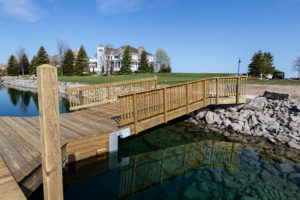Gangways & ramps
Gangways and ramps are integral components of every floating dock installation and provide access between shore and dockage. The appropriate type and size are generally dictated by elevation of shore grade, range water level fluctuation, and maximum slope requirements. For projects where ADA compliance is necessary, a minimum clear width of 5′-0″ must be provided, and slopes cannot exceed a ratio of 1″ vertical drop for every 12″ of horizontal distance. Regardless of the final design, utility lines can be easily incorporated and concealed to maintain a clean aesthetic.
PRODUCT FEATURES

Depending on the application, timber-frame ramps with a maximum length of 24′ may be sufficient. This type is most commonly associated with residential settings and / or projects where ADA compliant slopes are not deemed necessary. Alternatively, aluminum truss-frame gangways can be used where longer spans are required, extending up to 80′ from the shore connection point. This configuration (in a marine environment) satisfied ADA Reasonable Accommodation standards and eliminates the need for intermediate flat landings.
 Various types of railing are offered for both timber ramps and aluminum gangways. Wooden baluster (i.e. spindle) style is by far the most common, however a simplified three-tier variant is also available. Railing can be entirely omitted on timber ramps to achieve an extremely clean look while offering even more tie-up space. Please note that aluminum gangways must include truss framework.
Various types of railing are offered for both timber ramps and aluminum gangways. Wooden baluster (i.e. spindle) style is by far the most common, however a simplified three-tier variant is also available. Railing can be entirely omitted on timber ramps to achieve an extremely clean look while offering even more tie-up space. Please note that aluminum gangways must include truss framework.
 The beginning location of a floating dock is always determined by the length of its gangway, however returns (i.e. switchbacks) may be incorporated to maximize dockage space. Although a number of factors impact the scale and feasibility of such an addition, it generally provides a favorable return on investment by offering up to four additional slips per side.
The beginning location of a floating dock is always determined by the length of its gangway, however returns (i.e. switchbacks) may be incorporated to maximize dockage space. Although a number of factors impact the scale and feasibility of such an addition, it generally provides a favorable return on investment by offering up to four additional slips per side.
 When a gangway or ramp is simply not needed, our articulating stairway product provides a cost-effective and simple means of dock access. Heavy-duty wheels allow the stairs to automatically adjust as water levels fluctuate by collapsing with a rise and extending as a decline. For projects characterized by a significant range of water levels, we typically recommend obtaining two versions (one large and one small) which may be easily swapped when either version approaches its travel limit.
When a gangway or ramp is simply not needed, our articulating stairway product provides a cost-effective and simple means of dock access. Heavy-duty wheels allow the stairs to automatically adjust as water levels fluctuate by collapsing with a rise and extending as a decline. For projects characterized by a significant range of water levels, we typically recommend obtaining two versions (one large and one small) which may be easily swapped when either version approaches its travel limit.
